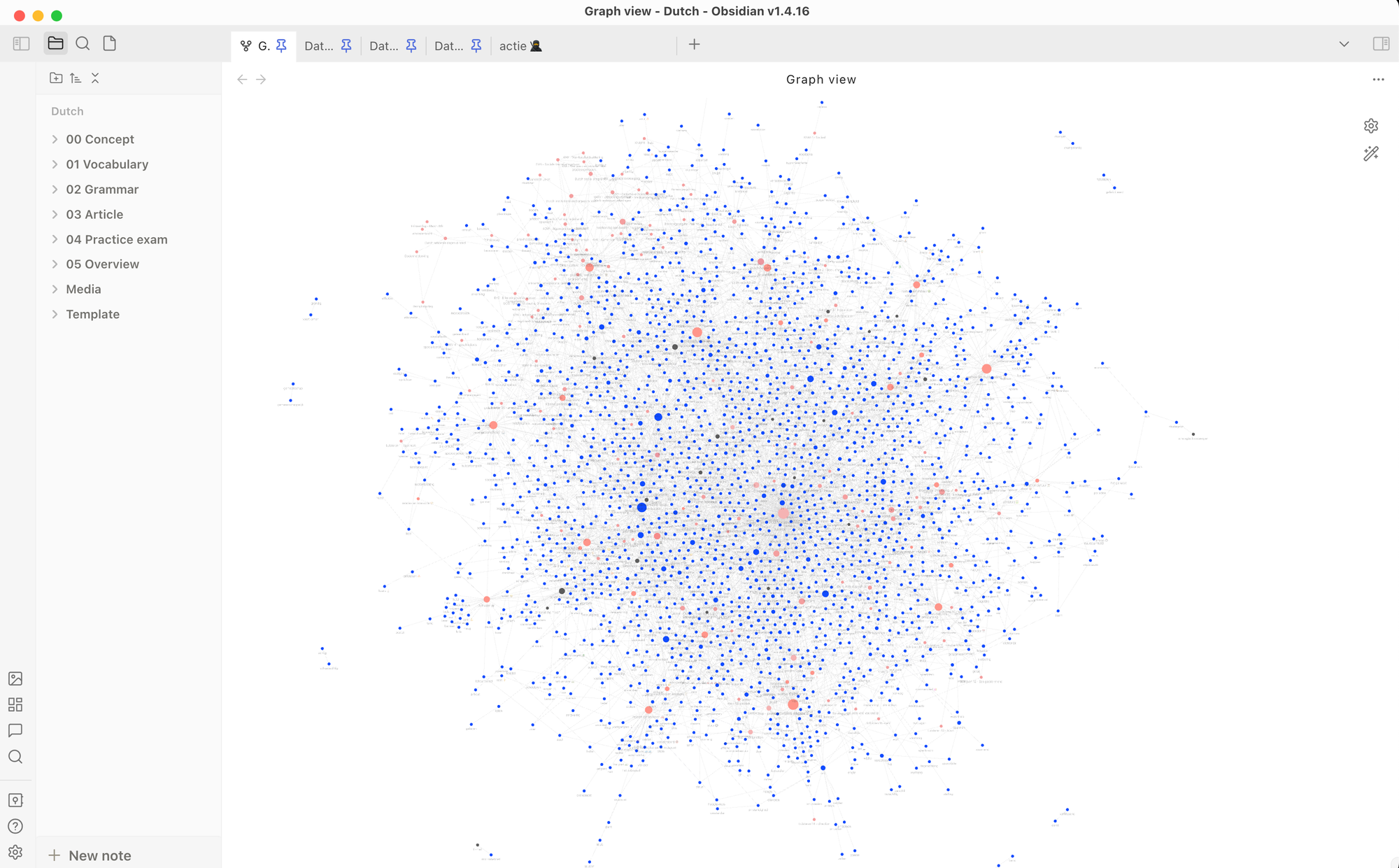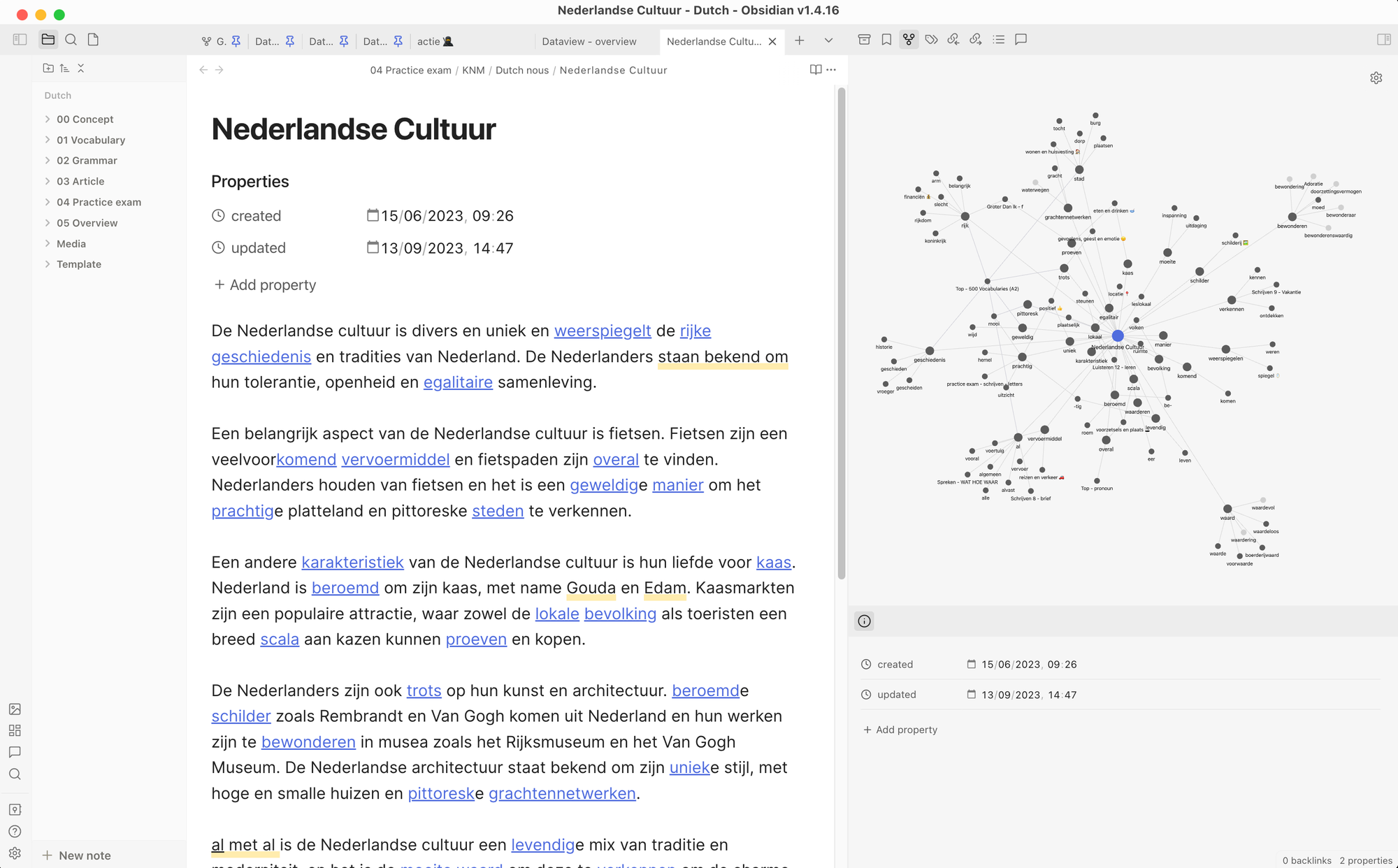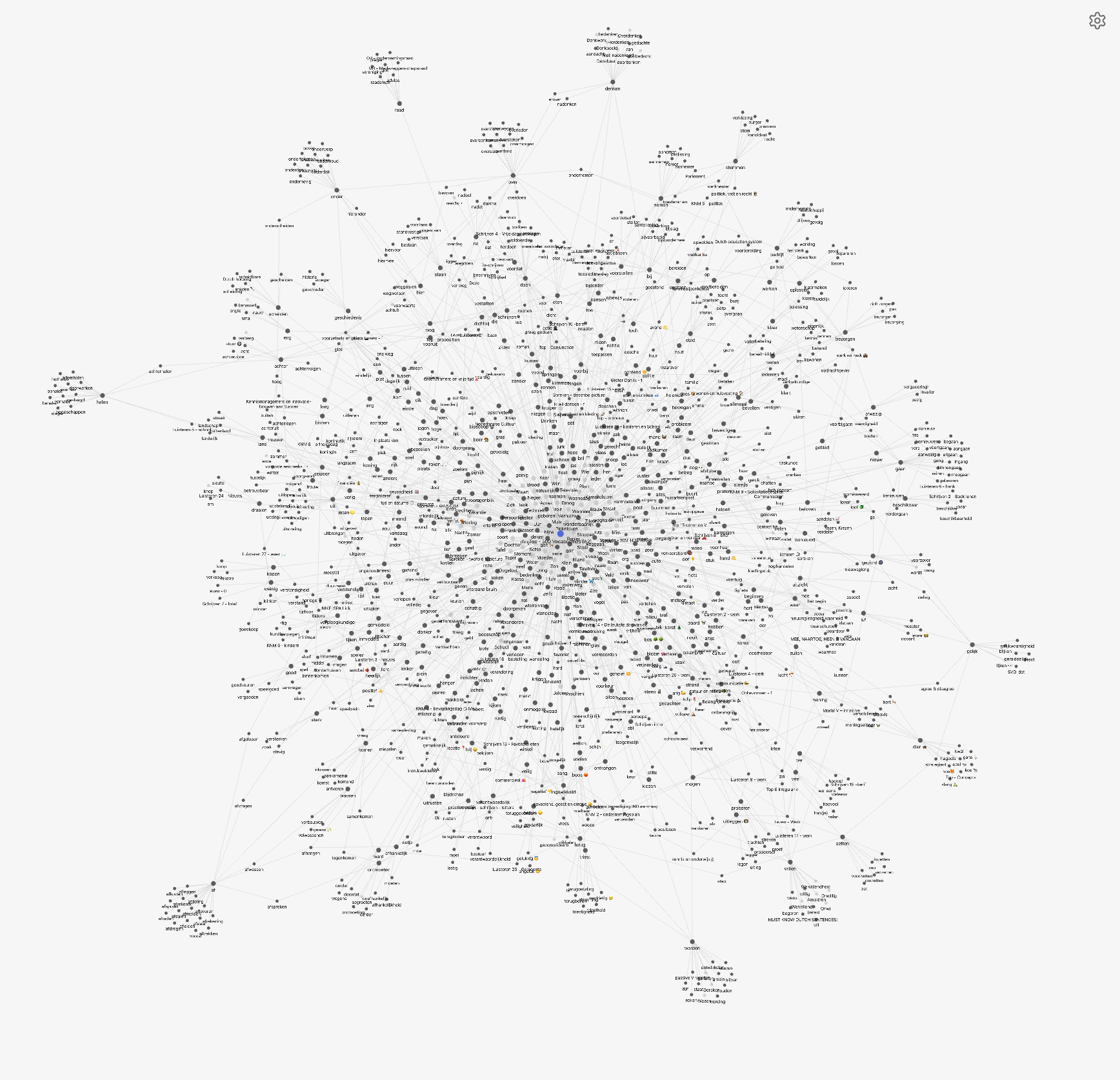To begin with
This year, I aim to pass the Dutch Integration Exams (Inburgeren), equivalent to the A2 language level. Dutch will be my third language; honestly, learning English was a painful journey for me for a long time. I was frustrated by the design of school materials and exams. That's why I decided to be creative about my "learning" approach and use my knowledge management skill to build my personal knowledge base in obsidian for preparation.
Before starting my unconventional preparation for this year, I must confess that I am not starting from scratch. I had an intense A1-A2 course for 10 days at the university in the summer of 2018 and have been using Duolingo on and off since 2017 (⚡️ 32017 xp). Thus, I appreciate the fundamental knowledge I have acquired and enjoy how Duolingo helps me build my practice routines.
Aside from building my knowledge base in obsidian, I also started to get more surrounded by Dutch conversations; for example, Dutch radio BNR is my favourite one during my daily commute since the content is close to my interest, innovation & international news. My lovely Dutch colleagues and friends also help me with some " interesting " words, but hey, Dutch is Dutch; more is always better!

About Obsidian
Obsidian is a minimalist Markdown editor/note-taking app. One of its core features is to enable users to create links between notes and have a network graph view to see the connections between notes. Moreover, it's a community-driven app where people share hundreds of self-built plug-ins to help others build their "2nd brain".

If it's the first time you hear about obsidian, check this video
Why a knowledge base and why using Obsidian?
Memorizing things is not my strength. It works for me better when I can see and visualize connections between things. A knowledge base in Obsidian helps me navigate my learning paths, group related information and review my learning content effectively.
I am a massive fan of databases and systems. It's been a while since I wanted to learn how to establish a knowledge base using a network approach in Obsidian. That's why it's a great idea to combine language learning with something I'm obsessed with, "time will fly!" I thought.
Time did fly! After 50 days, I am getting more mature with how to organize the data and have developed several learning flows that are easy to follow on daily bases. Below, I will share some features and methods I used in 3 categories: Gathering, Organizing, and Practice/Review.

1-Gathering
A simple workflow - take quick notes for every vocabulary I encounter
No one would disagree that a certain amount of vocabulary is essential to language learning. My goal is to collect 1500 words in my database while reading articles, practicing Duolingo and watching youtube videos. Thus I need to create a smooth flow to input the data. After some trial and error, I finalized a simple template with essential data columns that I am happy with and could be used for creating data overviews. I also stored my vault on iCloud to easily sync it on my phone so I can input the data wherever I am with my phone. At the stage of gathering, the quality or the completion of the data is not the main focus, if I don't have much time, I only input the title and maybe a photo if it's applicable.
Youtube and Duolingo are my primary source of learning content. What's more, I use it to collect content that I am interested such as "NIKE product description", "news on NOS", or a "Linkedin Post". And What I found recently that's powerful is to use ChatGpt to generate content that fits both my interest and difficulty level. Moreover, ChatGpt is handy when I need an explanation/examples of words or want to know the differences between certain words. It works really well by far! Feels like I have a private tutor. Two plug-ins I use for OpenAI API connection are Smart connections and TextGenerator.


My facourite youtube channel for dutch learning!
Features:
- Dataview
It is a community plugin that turns the knowledge base into a database that you can query from. As you can see above, I use it to create a list, in which I can easily spot data that are not completed and have the total number of vocabulary in my database.

Learn more abour DATAVIEW
- Template
With this core plug-in, you can quickly create a template that can be inserted using hotkeys. Moreover, it helps me to create a consistent dataset for Dataview - Icloud sync
If you check the obsidian web, you will see a subscription plan which enable cross device sync. However, obsidian is a "document reader", which means if you have your files stored on cloud, then you can use the obsidian phone app to read the file anytime whitout paying the subscription. - TextGenerator & Smart connections
After connecting to your OpenAI API, you can use the same ChatGpt feature in your Obsidian environment. Of course, you can also use ChatGpt via your browser; it's just more efficient for me to build the workflow in Obsidian; plus, it's relatively cheap compared to the subscription plan if you want to make sure it's always available whenever you need it.


2 - ORGANIZING
A simple system based on concepts and themes
At the beginning, it wasn't clear for me how to group vocabularies. I use #tag to label things by my initiation. At some point the system became too complicated and I can't remember anymore what "concepts" I have. At the stage with around 200 words in the database, I use ChatGpt to define top 20 common themes for language learning, then I group them in 4 categories so I can navigate them easily later. It was a fun exercise to categorize words into these boxes since it's the first time I dive into how I "learn" and "name" the world, how language itself is a knowledge base we create, and view the world as a total system.

Using roots, pre/suffix, and relations to expand the network
Another way to build the network system is to identify its root, prefix, and suffix. This was challenging for me at the beginning; for example, the root might be a variation form that can't be directly spot on, or I already have a vocabulary with the wrong tense in the database. Luckily, the process got smoother after some conversations with ChatGpt and Bing chat.

Still, many words remained uncategorised in the database, but that's ok! Through the process, new links will be created once their relatives are added. Orephan notes are waiting for me to revisit and be critical about whether there are new words I can add to bridge them to the network.


3 - REVIEW (In May 2023)
Lastly, I have to review and revisit notes to enhance my memory. Core features such as random notes, local graphs and (un)linked mentions help me get into the rabbit holes and have the chance to review related vocabulary at once. Another feature that allows me to create a fun process is using review flashcards, which automatically identify highlights/bold content in the notes and make a flash card for me to refresh. I only found this plug-in at the stage with around 400 words, so the format wasn't designed for it, and many do not need a highlight. Through the progress of revisiting my old notes randomly, I gradually updated the content so I could better use this feature.


NEXT STEP
Until now (637 vocabularies in the database), I am pleased with the learning approach, and I notice that Dutch is becoming less intimidating. I get curious whenever I see a new word, and I enjoy the time building my digital base so much that I can easily spend hours practising. The next stage is to do as many practice exams and have as many daily conversations as possible. ChaptGpt will continually play a critical role in my journey.
Update November 2023
I passed the exam! What a relief. Over the past months, I have inputted 2181 vocabulary words into the database and improved the system and data structure. 'Less is more' is one of the lessons I've learned. Also, thanks to the new obsidian properties update, the interface has become even more user-friendly now.





You can now download the template and start your learning journey :

